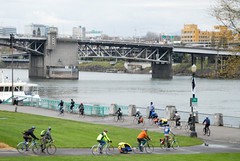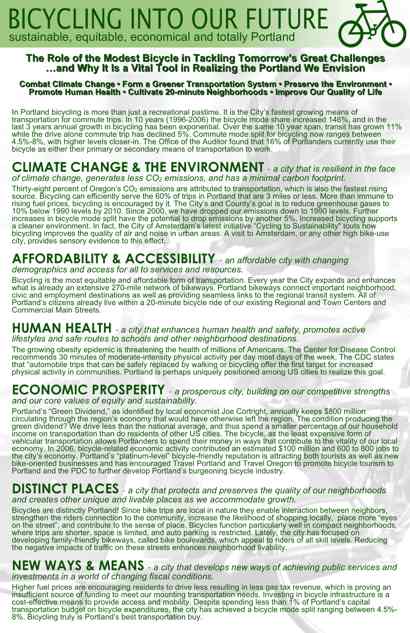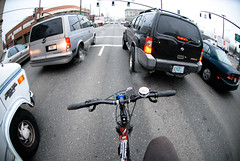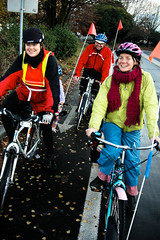“Bicycling is the most equitable and affordable form of transportation… All of Portland’s citizens already live within a 20-minute bicycle ride of our existing Regional and Town Centers and Commercial Main Streets.”
–From a document produced by PDOT titled Bicycling Into Our Future
Steve Dotterer with the City of Portland Bureau of Planning made a presentation about The Portland Plan at last night’s meeting of the Portland Bicycle Advisory Committee.
According to the official website, The Portland Plan “is an inclusive, citywide effort to guide the physical, economic, social, cultural and environmental development of Portland over the next 30 years.”
The three-year effort is just getting underway, and will ultimately tackle the prodigious task of completely re-analyzing nearly every facet of Portland’s urban design in an attempt to update our city’s Comprehensive Plan and our Central City Plan (which were last updated in 1980 and 1988 respectively).

future of not just Portland, but (hopefully)
all American cities.
(Photos © J. Maus)
The importance of this effort cannot be overstated. The policies and principles adopted in the end will lay the groundwork for how we move forward into what is likely to be an era of massive change brought on by increasing population pressure, rising energy costs, and other factors.
So, how do bikes figure into this mix? In many ways.
The people working on The Portland Plan have said the plan will be “developed with community input based on the following critical issues”:
- Climate Change
- Affordability and Accessibility
- Human Health and Safety
- Economic Prosperity and Creative Vitality
- Distinctive and Well-Designed Places
- High-Performing Natural Systems (how to maintain natural areas and ecosystems)
- New Ways and Means (how to pay for the services we need)
Thankfully, PDOT’s bike coordinator Roger Geller (with help from staffer Denver Igarta) is already on the case. Geller has taken each of those critical issues and drafted a summary paragraph on how bicycles relate to them. The resulting, one-page document, Bicycling Into Our Future succinctly answers the question I have posed in the title of this article — Why are bicycles key to the future of Portland?
I share this information not necessarily because it’s news to many of you (most of the points made I have covered in some form previously), but because of the context and format it is written in. These points should be memorized by advocates across the nation, shared with co-workers and bosses, brought up with politicians and candidates, written in letters to editors, blogged about, and so on.
I’ve pasted the text from the document below (emphasis mine) and you can view and download a PDF at the end of this article:
Climate Change & The Environment
Thirty-eight percent of Oregon’s CO2 emissions are attributed to transportation, which is also the fastest rising source. Bicycling can efficiently serve the 60% of trips in Portland that are 3 miles or less. More than immune to rising fuel prices, bicycling is encouraged by it. The City’s and County’s goal is to reduce greenhouse gases to 10% below 1990 levels by 2010. Since 2000, we have dropped our emissions down to 1990 levels.
Further increases in bicycle mode split have the potential to drop emissions by another 5%. Increased bicycling supports a cleaner environment. In fact, the City of Amsterdam’s latest initiative “Cycling to Sustainability” touts how bicycling improves the quality of air and noise in urban areas. A visit to Amsterdam, or any other high bike-use city, provides sensory evidence to this effect.
Affordability and Accessibility
Bicycling is the most equitable and affordable form of transportation. Every year the City expands and enhances what is already an extensive 270-mile network of bikeways. Portland bikeways connect important neighborhood, civic and employment destinations as well as providing seamless links to the regional transit system. All of Portland’s citizens already live within a 20-minute bicycle ride of our existing Regional and Town Centers and Commercial Main Streets.
Human Health
The growing obesity epidemic is threatening the health of millions of Americans. The Center for Disease Control recommends 30 minutes of moderate-intensity physical activity per day most days of the week. The CDC states that “automobile trips that can be safely replaced by walking or bicycling offer the first target for increased physical activity in communities. Portland is perhaps uniquely positioned among US cities to realize this goal.
Economic Prosperity
Portland’s “Green Dividend,” as identified by local economist Joe Cortright, annually keeps $800 million circulating through the region’s economy that would have otherwise left the region. The condition producing the green dividend? We drive less than the national average, and thus spend a smaller percentage of our household income on transportation than do residents of other US cities. The bicycle, as the least expensive form of vehicular transportation allows Portlanders to spend their money in ways that contribute to the vitality of our local economy.
In 2006, bicycle-related economic activity contributed an estimated $100 million and 600 to 800 jobs to the city’s economy. Portland’s “platinum-level” bicycle-friendly reputation is attracting both tourists as well as new bike-oriented businesses and has encouraged Travel Portland and Travel Oregon to promote bicycle tourism to Portland and the PDC to further develop Portland’s burgeoning bicycle industry.
Distinct Places
Bicycles are distinctly Portland! Since bike trips are local in nature they enable interaction between neighbors, strengthen the riders connection to the community, increase the likelihood of shopping locally, place more “eyes on the street”, and contribute to the sense of place. Bicycles function particularly well in compact neighborhoods, where trips are shorter, space is limited, and auto parking is restricted. Lately, the city has focused on developing family-friendly bikeways, called bike boulevards, which appeal to riders of all skill levels. Reducing the negative impacts of traffic on these streets enhances neighborhood livability.
New Ways and Means
Higher fuel prices are encouraging residents to drive less resulting in less gas tax revenue, which is proving an insufficient source of funding to meet our mounting transportation needs. Investing in bicycle infrastructure is a cost-effective means to provide access and mobility. Despite spending less than 1% of Portland’s capital transportation budget on bicycle expenditures, the city has achieved a bicycle mode split ranging between 4.5%-8%. Bicycling truly is Portland’s best transportation buy.
View the document below. Click on it to download a PDF (630k):

For more on The Portland Plan visit PortlandOnline.com/PortlandPlan and stay tuned for more coverage.




